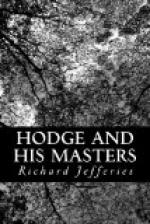green. The drooping foliage of the birch exhibits
a paler yellow; the nut-tree bushes shed brown leaves
upon the ground. Perhaps the beech leaves are
the most beautiful; two or three tints are blended
on the topmost boughs. There is a ruddy orange
hue, a tawny brown, and a bright green; the sunlight
comes and mingles these together. The same leaf
will sometimes show two at least of these colours—green
shading into brown, or into a ruddy gold. Later
on, the oaks, in a monochrome of buff, will rival
the beeches. Now and then an acorn drops from
the tree overhead, with a smart tap on the hard earth,
and rebounds some inches high. Some of these
that fall are already dark—almost black—but
if opened they will be found bored by a grub.
They are not yet ripe as a crop; the rooks are a good
guide in that respect, and they have not yet set steadily
to work upon this their favourite autumn food.
Others that have fallen and been knocked out of the
cup are a light yellow at the base and green towards
the middle and the point; the yellow part is that
which has been covered by the cup. In the sward
there is a small hole from out of which creeps a wasp
at intervals; it is a nest, and some few of them are
still at work. But their motions are slow and
lack vivacity; before long, numbers must die, and
already many have succumbed after crawling miserably
on the ground which they spurned a short while since,
when with a brisk buzz they flew from apple to plum.
In the quiet woodland lane a covey of partridges are
running to and fro on the short sward at the side,
and near them two or three pheasants are searching
for food. The geometrical spiders—some
of them look almost as big as a nut—hang
their webs spun to a regular pattern on the bushes.
The fungi flourish; there is a huge specimen on the
elm there, but the flowers are nearly gone.
A few steps down the lane, upon looking over a gate
into a large arable field where the harrow has broken
up the clods, a faint bluish tinge may be noticed
on the dull earth in the more distant parts. A
second glance shows that it is caused by a great flock
of woodpigeons. Some more come down out of the
elms and join their companions; there must be a hundred
and fifty or two hundred of them. The woodpigeon
on the ground at a distance is difficult to distinguish,
or rather to define individually—the pale
blue tint seems to confuse the eye with a kind of haze.
Though the flock take little notice now—knowing
themselves to be far out of gunshot—yet
they would be quickly on the alert if an attempt were
made to approach them.




